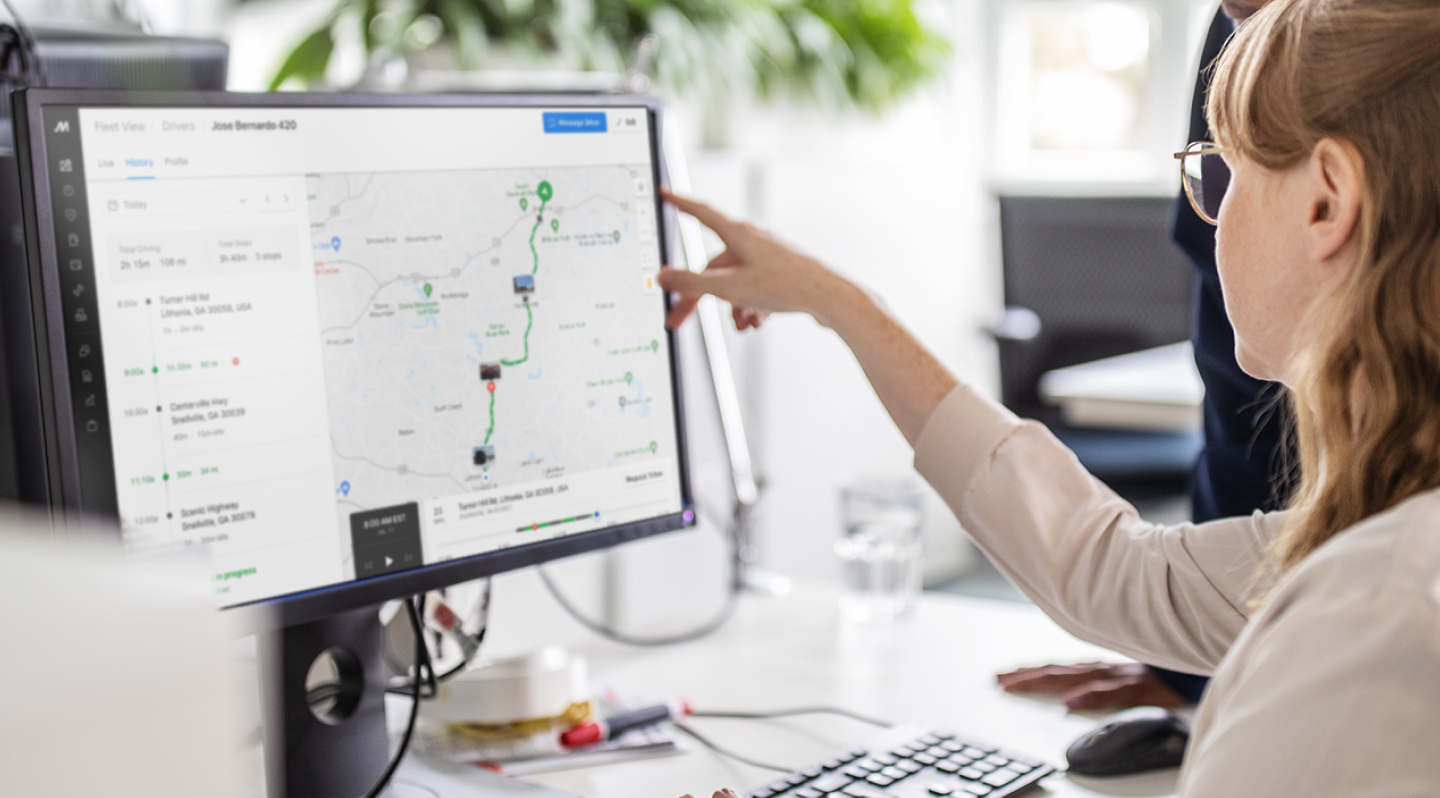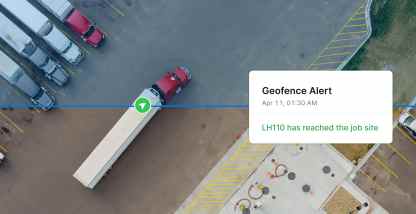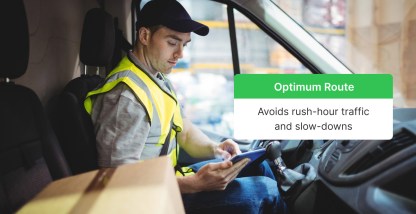GPS technology is omnipresent today. Companies can find their product in warehouses using GPS. The technology has replaced paper maps for directions. Parents even track their offspring via GPS in our phones. The uses of GPS technology continue to grow. For commercial companies, GPS fleet tracking helps improve productivity, streamline dispatch, secure assets and much more. We’ll discuss various industry applications too in this article exploring fleet tracking solutions and how they help commercial fleets.
What is GPS fleet tracking software?
Fleet GPS tracking solutions track the location of an object using triangulation. We’ve been using triangulation to locate objects for over one hundred years already. But GPS tracking technology uses satellites in medium-earth orbit to measure distances and give fleet managers live updates in real time.
This advanced technology pinpoints specific addresses and provides transparency into vehicle speed and direction. Today’s GPS functions with a latency typically as fast as a few seconds. A 30 second update frequency would be slow, reflecting the vehicle is in a location with slower network connectivity.
How does GPS fleet tracking work?
GPS tracking devices emit radio signals that use cellular and satellite transmissions. By knowing where that cell tower or satellite is, and measuring the strength of the signal and its direction, fleet vehicle GPS tracking systems can triangulate where that signal originated. This signal is what makes it possible for a commercial fleet manager to determine where a vehicle is, how fast it’s traveling, and its estimated time of arrival. Don’t worry, the manager isn’t doing the actual triangulation, the technology does that and simply serves up the accurate locations and times.
You attach a GPS tracker to your commercial fleet vehicle. That transmits data to at least three satellites from the global navigation satellite system (GNSS) network. This is used to determine the tracker’s distance from the satellites and identify the vehicle’s latitude and longitude coordinates (including time and elevation). When you use vehicle GPS tracking systems, you can connect to the cloud server that picks up the transmitted coordinates to gain real-time data about your vehicles.
Uses of fleet vehicle GPS tracking
GPS fleet tracking offers many benefits for fleet managers and drivers. The many applications for fleet and asset tracking include:
- Live fleet tracking and reporting. With GPS technology, fleet managers can locate vehicles and assets in real time and make more data-informed strategic decisions and to increase asset and vehicle return on investment (ROI).
- Route optimization and planning. Tracking & monitoring systems can let managers know how long drivers stay at loading docks before moving on. If the duration is too long, the manager can change dispatch expectations or find ways to make pickups to shorten loading time and boost daily productivity.
- Geofencing. Prevent asset theft and unauthorized use by setting up notifications to alert management if a vehicle or fleet equipment leaves an established boundary. Or, know when assets arrive at a certain location when the fleet tracking shows arrival within a geofenced area.
- Vehicle health monitoring. GPS fleet tracking isn’t just about location. You can use that accurate data on vehicle movements and locations to better understand fuel consumption and emissions levels, time spent on site, and equipment usage.
Benefits of using a GPS fleet tracking software
Real-time GPS fleet tracking can help simplify daily fleet operations. When GPS data is paired with fleet management software you can track your fleet and extend visibility into your operations all in one dashboard view. Commercial fleets enjoy several advantages including:
- Improved productivity. Integrating GPS tracking with telematics data about speed, direction, and fault code, you can improve fleet efficiency. The technology also reduces your dependency on phone check-ins and manual communication to keep everything running smoothly, more simply.
- Enhanced driver and asset safety. Knowing where your drivers, vehicles, and equipment are at all times you can optimize routes to avoid danger areas, bad weather, or traffic. Plus, you’ll know when vehicles or other assets detour from the planned routes and confirm when assets arrive at their intended destination.
- Simplified compliance. Confirm driver HOS availability, trailer type, and other vehicle details in one, comprehensive data source which also automates workflow and streamlines reporting.
- Realized cost savings. Improved productivity and fleet efficiency translate to operation gains. Being able to optimize routes to prevent collisions can directly impact the bottom line. So can cutting fuel costs, anticipating maintenance needs, and avoiding valuable asset losses.
- Boosted customer satisfaction. With the ability to ensure your drivers are on schedule and track ETAs in real time, you’ll be able to communicate with customers in advance to manage expectations and improve satisfaction.
These advantages are overarching for all commercial fleets leveraging vehicle tracking technology. Let’s take a look next at GPS fleet tracking uses in particular industries.
GPS fleet tracking solutions across industries
This article focuses on fleet management at large. Let’s look now at examples of GPS trackers improving operations across specific industries.
Trucking and logistics
Whether you have one truck or one hundred forklifts, trucking and logistics industry players will benefit from the ability to monitor everything, from anywhere, in a consolidated dashboard view. With fleet tracking solutions you can safeguard against asset theft and misuse. Plus, you can maximize utilization with improved routing that draws on GPS data to avoid bad weather, traffic, or idle time. The GPS data can also improve communication with drivers, which lets you simultaneously enhance customer communications and provide more accurate delivery windows and prevent delivery disputes.
Oil and gas
With assets often in use across several sites, the oil and gas industry can better secure valuable equipment with real-time asset tracking. Knowing where everything is at any given time can also allow you to optimize asset utilization. Streamline dispatch with the ability to track locations, find drivers by proximity, monitor schedules, and notify receiving clients when they can expect arrival.
Construction
Construction fleets can use a fleet GPS system to improve overall efficiency, productivity, and financials. With GPS-based fleet tracking and geofence warnings you can track expensive equipment and prevent thefts. Being able to view the precise locations of every asset and driver can also help improve cycle times and utilization.
Food and beverage
Accurate ETAs and optimized routing depend on full visibility into your vehicles and drivers. GPS tracking provides critical delivery information to help managers find the shortest, fastest, most efficient routes in real-time. Customer experience also benefits when food and beverage fleets have GPS-enabled ETA data to draw on to communicate scheduled arrival.
Delivery
“When will my package be delivered?” That’s the million dollar question delivery fleets face every day, with every order. Late deliveries are a major concern. Yet with GPS trackers on fleet vehicles, you can know exactly where vehicles are and communicate with customers exactly when to expect delivery. With accurate, real-time information, you can also optimize routes on the fly to save fuel and time.
Passenger transit
Passenger transit is another industry where customers want to know exactly when to expect to be picked up and dropped off at their destination. GPS function improves communication and provides greater accuracy for better customer service. Fleet managers can optimize asset utilization as well with the monitoring tools making it possible to find the nearest driver, track locations, share details, and message drivers to coordinate smooth trips.
Agriculture
With agriculture, assets can be spread out with monitoring challenged by location and conditions. Yet, GPS tracking protects equipment and vehicles from misuse and theft by providing accurate, real-time insights on everything, anywhere, in a dashboard view. Rely on this technology to simplify deliveries with the benefit of the full picture on road conditions, weather, and more to anticipate delays or reroute drivers as needed.
Limitations and challenges of GPS technology
As with any technology, there are some limitations and challenges that need to be addressed with GPS fleet tracking. For one, securing the satellite system and GPS tracking data requires ongoing attention. Cyber attackers are always on the lookout for new targets. Another fear is that a foreign entity or other bad actor might find a way to jam the GPS signals. However, the federal government, military agencies, and other entities are all intent on protecting GPS communications and finding alternatives to provide backup in the event of an issue.
GPS signal failure is a more commonplace challenge. No ill-intentioned individual needs to be involved. It could simply be a mountain in the way. Or being too far from the receiving tower or satellite. Still, new additions to the satellite and cellular infrastructure are always helping while manufacturers simultaneously work to enhance signal deliverability.
Fleet GPS trackers are also power gobblers, yet they are typically solar or battery operated. At the same time, they must be manufactured compactly in order to be mobile. Motive uses an Asset Gateway device attached to your equipment, with a powerful battery life that ensures continuous operation, even on remote job sites.
What is GPS integration with other technologies?
You can get more out of your GPS tracking technology by integrating it with other innovations. For example, most good fleet GPS tracking companies integrate monitoring with the electronic logging devices (ELD) many commercial drivers are required to use. Pairing these two can help with compliance by using GPS data to notify drivers of the nearest place to rest for required breaks and to automate IFTA fuel tax reporting with state mileage calculations.
GPS fleet tracking software can also reduce paperwork and make the drivers’ job easier. Instead of having to keep manual mileage logs, they can rely on an intuitive app to report GPS data back to the office. This benefits fleet managers as well as they no longer have to wait days or weeks for the drivers to report the data from the road.
Pairing GPS telematics data with fleet maintenance software can also support preventative maintenance. Instead of making maintenance decisions based on time or mileage, you can track fleet GPS readings of distance traveled, at what speed, and in what conditions to anticipate when to schedule maintenance and avoid asset downtime.
Motive is always looking for ways to better integrate fleet GPS tracking data with its telematics and fleet management offerings. On the horizon? Being able to monitor fuel spend to prevent theft by matching receipts with tracking data to ensure the fuel is getting put in the tank of the fleet’s vehicle. Plus, autonomous vehicles will rely on GPS tracking to follow established delivery routes.
What is a GPS solution my fleet can trust?
Now that you could explain to fellow stakeholders what is GPS fleet tracking technology and how it helps, it’s time to find the right solution for your fleet. The best GPS fleet tracking solution will improve your operations and maximize asset usage while safeguarding asset safety and enhancing customer experience.
Motive’s GPS fleet tracking software allows you to monitor everything, anywhere, with real-time visibility into vehicles and equipment to streamline dispatch, track performance against schedules, and prevent theft or misuse. Set up geofence notifications to gather data on detention times and increase efficiency. Use the insights to increase profitability as well.
Request a demo today to see why Motive was selected as a Category Leader in GPS fleet tracking software by Get App.









